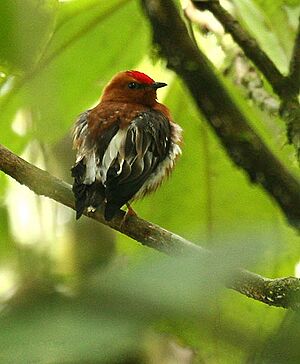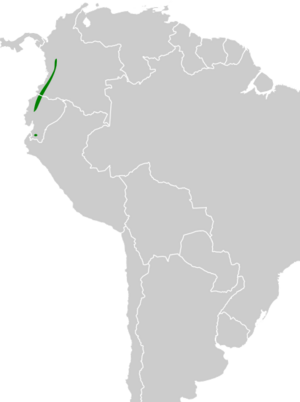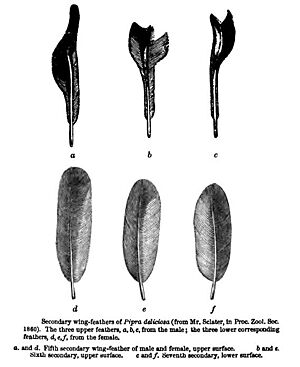Club-winged manakin facts for kids
Quick facts for kids Club-winged Manakin |
|
|---|---|
 |
|
| Male in NW Ecuador | |
| Conservation status | |
| Scientific classification | |
| Genus: |
Machaeropterus
|
| Species: |
deliciosus
|
 |
|
The club-winged manakin (Machaeropterus deliciosus) is a small, colorful bird. It lives in the cloud forests on the western side of the Andes Mountains. You can find it in Colombia and northwestern Ecuador. Manakins are a family of small birds found in tropical Central and South America. This special bird is known for its unique way of making sounds with its wings!
Contents
Wing Music: How This Bird Sings with Its Feathers!
The club-winged manakin is amazing because it can make musical sounds using its wings! This is called "sonation." Many other manakins also make sounds with their wings, but the club-winged manakin's sound is very special.
Why Do They Make Sounds?
Male manakins make these sounds to attract female manakins. It's like a special show to find a mate. Over time, manakins have changed their wings in unique ways just to make these sounds. Some manakins make popping sounds, and others make whooshing noises when they fly. But the club-winged manakin is the only one that makes musical notes with its wings!
How the Wings Make Music
Each wing of the club-winged manakin has a special feather. This feather has at least seven small ridges, like tiny bumps, along its middle part. Next to this ridged feather is another feather with a stiff, curved tip.
When the bird wants to make music, it raises its wings over its back. Then, it shakes them back and forth super fast! It shakes them more than 100 times every second. (To compare, a hummingbird flaps its wings about 50 times a second.)
As the bird shakes its wings, the stiff tip of one feather hits each ridge on the other feather. It hits each ridge twice: once when the feathers come together, and again when they move apart. This means one wing can make 14 sounds during each shake! Since the bird shakes its wings 100 times a second, it can make about 1,400 single sounds in that short time.
Strong Bones for Sound
To handle all this fast shaking and hitting, the club-winged manakin has very strong, solid wing bones. Most birds have hollow bones to make them lighter for flying. But the club-winged manakin's solid bones help it make its special wing music. Interestingly, female manakins also have these solid wing bones, even though they don't use them to make sounds.
A Rare Talent
This way of making sound, like a "spoon and washboard," is common in insects. But it's very rare to see it in animals with backbones, like birds!



